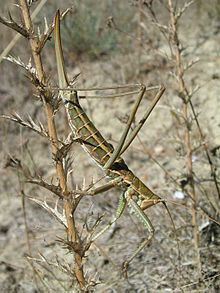
A | B | C | D | E | F | G | H | CH | I | J | K | L | M | N | O | P | Q | R | S | T | U | V | W | X | Y | Z | 0 | 1 | 2 | 3 | 4 | 5 | 6 | 7 | 8 | 9
| Predatory katydids | |
|---|---|

| |
| Mature Saga pedo | |
| Scientific classification | |
| Domain: | Eukaryota |
| Kingdom: | Animalia |
| Phylum: | Arthropoda |
| Class: | Insecta |
| Order: | Orthoptera |
| Suborder: | Ensifera |
| Family: | Tettigoniidae |
| Subfamily: | Saginae Brunner von Wattenwyl, 1878 |
The Saginae, commonly known as the predatory katydids or predatory bush-crickets, is a subfamily of the family Tettigoniidae (the bush-crickets or katydids). They are mostly found in Europe,[1] west and central Asia and southern Africa.[2]
The Saginae are specialist carnivores, which is unusual among the Orthoptera.[3] Their specialist carnivory and appropriately adapted digestive tracts even were regarded as unique in the order Orthoptera, but at least some members of two other subfamilies, the Austrosaginae and Listroscelidinae are partly or completely predatory as well, and until recently those subfamilies were included in the Saginae.
Genera and selected species

- Clonia Stål, 1855
- Clonia wahlbergi Stål, 1855
- Cloniella Kaltenbach, 1971
- Cloniella praedatoria (Distant, 1892)
- Cloniella zambesica Kaltenbach, 1971
- Emptera Saussure, 1888
- Emptera indica (Herbst, 1786)
- Peringueyella Saussure, 1888
- Peringueyella jocosa Saussure, 1888
- Peringueyella macrocephala (Schaum, 1853)
- Peringueyella rentzi Kaltenbach, 1981
- Peringueyella zulu Kaltenbach, 1971
- Saga Charpentier, 1825
- Saga pedo (Pallas, 1771)
Description

Members of the Saginae are gracile and elongated in build compared to say, most locusts or crickets, but their four anterior walking legs, as opposed to their two posterior leaping legs, are powerful and lined with spines, mainly along their inner edges. They apply those inner spines in clasping their prey. Some species have spines on the outer surfaces and on the leaping legs as well; those external spines probably are defensive in function. The jaws of Saginae are not spectacular, but are large, powerful, sharp, and businesslike, as befits predators, and the insects do not hesitate to bite when handled.
The Saginae are large insects, some species with a body length of more than 50 mm, not counting the antennae or ovipositor, which are long, typically about as long as the body.
The ovipositor is long and sword-like, and used for oviposition in soil.
References
- ^ Lemonnier-Darcemont M., Darcemont C., Heller K.-G., Dutrillaux A.-M. & Dutrillaux B., (2016) : Saginae of Europe. Édition G.E.E.M., Cannes, France. 208 pp. ISBN 978-2-9537533-9-4
- ^ Orthoptera species file (retrieved 3 January 2018)
- ^ Holm, E.; Scholtz, C. H. (1985). Insects of southern Africa. London: Butterworths. ISBN 0-409-10487-6.
External links
 Media related to Saginae at Wikimedia Commons
Media related to Saginae at Wikimedia Commons
Text je dostupný za podmienok Creative Commons Attribution/Share-Alike License 3.0 Unported; prípadne za ďalších podmienok. Podrobnejšie informácie nájdete na stránke Podmienky použitia.
Antropológia
Aplikované vedy
Bibliometria
Dejiny vedy
Encyklopédie
Filozofia vedy
Forenzné vedy
Humanitné vedy
Knižničná veda
Kryogenika
Kryptológia
Kulturológia
Literárna veda
Medzidisciplinárne oblasti
Metódy kvantitatívnej analýzy
Metavedy
Metodika
Text je dostupný za podmienok Creative
Commons Attribution/Share-Alike License 3.0 Unported; prípadne za ďalších
podmienok.
Podrobnejšie informácie nájdete na stránke Podmienky
použitia.
www.astronomia.sk | www.biologia.sk | www.botanika.sk | www.dejiny.sk | www.economy.sk | www.elektrotechnika.sk | www.estetika.sk | www.farmakologia.sk | www.filozofia.sk | Fyzika | www.futurologia.sk | www.genetika.sk | www.chemia.sk | www.lingvistika.sk | www.politologia.sk | www.psychologia.sk | www.sexuologia.sk | www.sociologia.sk | www.veda.sk I www.zoologia.sk
